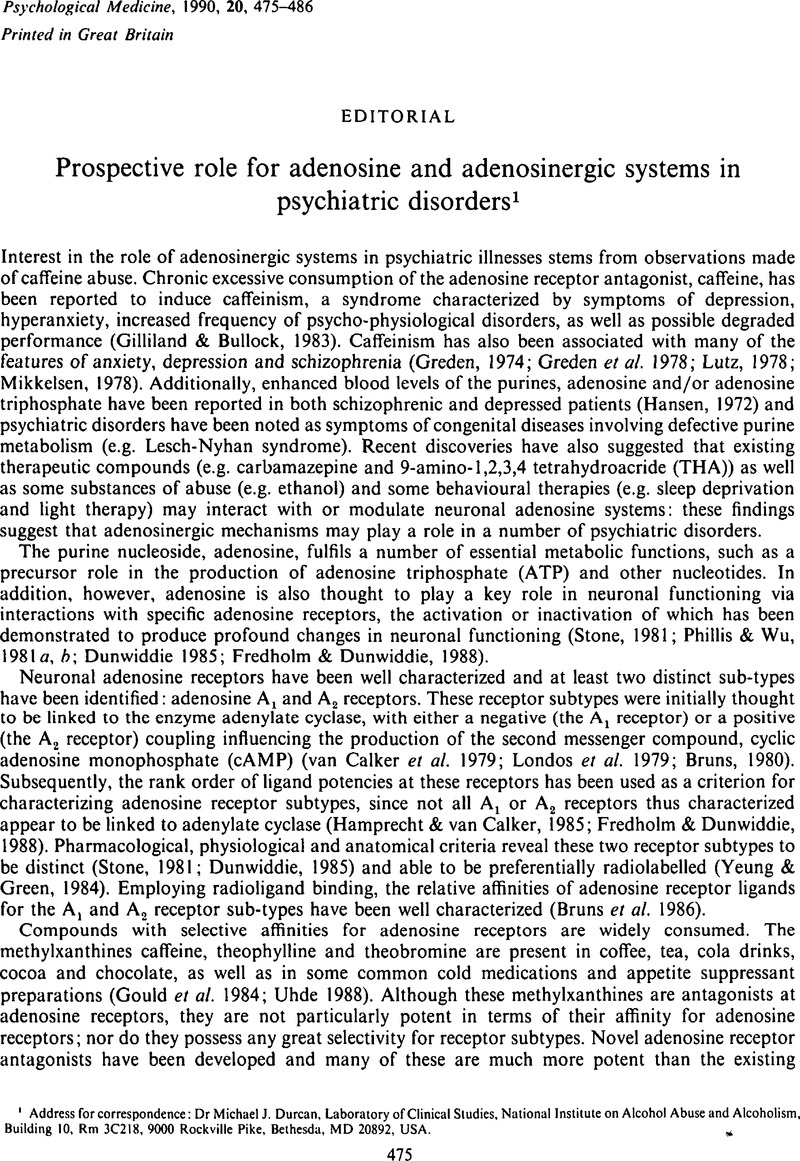Crossref Citations
This article has been cited by the following publications. This list is generated based on data provided by Crossref.
Daval, Jean-Luc
Nehlig, Astrid
and
Nicolas, Frédéric
1991.
Physiological and pharmacological properties of adenosine: Therapeutic implications.
Life Sciences,
Vol. 49,
Issue. 20,
p.
1435.
Ballard, C. G.
Mohan, R. N. C.
and
Handy, S.
1991.
Carbamazepine in alcohol withdrawal.
British Journal of Psychiatry,
Vol. 158,
Issue. 1,
p.
133.
Ferré, S.
Fuxe, K.
von Euler, G.
Johansson, B.
and
Fredholm, B.B.
1992.
Adenosine-dopamine interactions in the brain.
Neuroscience,
Vol. 51,
Issue. 3,
p.
501.
Motohashi, Nobutaka
Shioe, Kunihiko
Mitsushio, Hiroshi
and
Kariya, Tetsuhiko
1992.
Expects of Mood Stabilizers on Adenosine Systems in Rat Brain.
Psychiatry and Clinical Neurosciences,
Vol. 46,
Issue. 2,
p.
559.
Durcan, Michael J.
and
Morgan, Philip F.
1992.
Opioid receptor mediation of the hypothermic response to caffeine.
European Journal of Pharmacology,
Vol. 224,
Issue. 2-3,
p.
151.
van Calker, D.
and
Berger, M.
1993.
Biologische Psychiatrie der Gegenwart.
p.
288.
van Calker, Dietrich
and
Berger, Mathias
1993.
Possible role of adenosine receptors in psychiatric diseases.
Drug Development Research,
Vol. 28,
Issue. 3,
p.
354.
Fredholm, Bertil B.
Johansson, Björn
van der Ploeg, Ingeborg
Hu, Ping Sheng
and
Jin, Shaoyu
1993.
Neuromodulatory roles of purines.
Drug Development Research,
Vol. 28,
Issue. 3,
p.
349.
Motohashi, Nobutaka
1995.
Neurochemistry in Clinical Application.
Vol. 363,
Issue. ,
p.
189.
Waziri, Rafiq
Baruah, Sankar
Arndt, Stephan
Baumert, Karen
Cooney, Jon
and
Christensen, Laura
1996.
Psychosis and vulnerability to ECT-induced seizures.
Psychiatry Research,
Vol. 62,
Issue. 2,
p.
191.
Bertorelli, Rosalia
Ferri, Nives
Adami, Marina
and
Ongini, Ennio
1996.
Effects of selective agonists and antagonists for A1 or A2A adenosine receptors on sleep-waking patterns in rats.
Drug Development Research,
Vol. 37,
Issue. 2,
p.
65.
Popoli, Patrizia
Ferré, Sergi
Pèzzola, Antonella
Reggio, Rosaria
de Carolis, Arsenia Scotti
and
Fuxe, Kjell
1996.
Stimulation of adenosine A1 receptors prevents the EEG arousal due to dopamine D1 receptor activation in rabbits.
European Journal of Pharmacology,
Vol. 305,
Issue. 1-3,
p.
123.
Ferré, Sergi
Popoli, Patrizia
Tinner-Staines, Barbro
and
Fuxe, Kjell
1996.
Adenosine A1 receptor-dopamine D1 receptor interaction in the rat limbic system: modulation of dopamine D1 receptor antagonist binding sites.
Neuroscience Letters,
Vol. 208,
Issue. 2,
p.
109.
Gould, Todd D.
Chen, Guang
and
Manji, Husseini K.
2002.
Mood stabilizer psychopharmacology.
Clinical Neuroscience Research,
Vol. 2,
Issue. 3-4,
p.
193.
Gould, T D
Quiroz, J A
Singh, J
Zarate, C A
and
Manji, H K
2004.
Emerging experimental therapeutics for bipolar disorder: insights from the molecular and cellular actions of current mood stabilizers.
Molecular Psychiatry,
Vol. 9,
Issue. 8,
p.
734.



